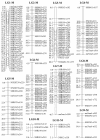Genetic linkage maps for Asian and American lotus constructed using novel SSR markers derived from the genome of sequenced cultivar
- PMID: 23170872
- PMCID: PMC3564711
- DOI: 10.1186/1471-2164-13-653
Genetic linkage maps for Asian and American lotus constructed using novel SSR markers derived from the genome of sequenced cultivar
Abstract
Background: The genus Nelumbo Adans. comprises two living species, N. nucifera Gaertan. (Asian lotus) and N. lutea Pers. (American lotus). A genetic linkage map is an essential resource for plant genetic studies and crop improvement but has not been generated for Nelumbo. We aimed to develop genomic simple sequence repeat (SSR) markers from the genome sequence and construct two genetic maps for Nelumbo to assist genome assembly and integration of a genetic map with the genome sequence.
Results: A total of 86,089 SSR motifs were identified from the genome sequences. Di- and tri-nucleotide repeat motifs were the most abundant, and accounted for 60.73% and 31.66% of all SSRs, respectively. AG/GA repeats constituted 51.17% of dinucleotide repeat motifs, followed by AT/TA (44.29%). Of 500 SSR primers tested, 386 (77.20%) produced scorable alleles with an average of 2.59 per primer, and 185 (37.00%) showed polymorphism among two parental genotypes, N. nucifera 'Chinese Antique' and N. lutea 'AL1', and six progenies of their F1 population. The normally segregating markers, which comprised 268 newly developed SSRs, 37 previously published SSRs and 53 sequence-related amplified polymorphism markers, were used for genetic map construction. The map for Asian lotus was 365.67 cM with 47 markers distributed in seven linkage groups. The map for American lotus was 524.51 cM, and contained 177 markers distributed in 11 genetic linkage groups. The number of markers per linkage group ranged from three to 34 with an average genetic distance of 3.97 cM between adjacent markers. Moreover, 171 SSR markers contained in linkage groups were anchored to 97 genomic DNA sequence contigs of 'Chinese Antique'. The 97 contigs were merged into 60 scaffolds.
Conclusion: Genetic mapping of SSR markers derived from sequenced contigs in Nelumbo enabled the associated contigs to be anchored in the linkage map and facilitated assembly of the genome sequences of 'Chinese Antique'. The present study reports the first construction of genetic linkage maps for Nelumbo, which can serve as reference linkage maps to accelerate characterization germplasm, genetic mapping for traits of economic interest, and molecular breeding with marker-assisted selection.
Figures


Similar articles
-
The Latest Studies on Lotus (Nelumbo nucifera)-an Emerging Horticultural Model Plant.Int J Mol Sci. 2019 Jul 27;20(15):3680. doi: 10.3390/ijms20153680. Int J Mol Sci. 2019. PMID: 31357582 Free PMC article. Review.
-
Optimization of linkage mapping strategy and construction of a high-density American lotus linkage map.BMC Genomics. 2014 May 15;15(1):372. doi: 10.1186/1471-2164-15-372. BMC Genomics. 2014. PMID: 24885335 Free PMC article.
-
Improving Nelumbo nucifera genome assemblies using high-resolution genetic maps and BioNano genome mapping reveals ancient chromosome rearrangements.Plant J. 2018 May;94(4):721-734. doi: 10.1111/tpj.13894. Epub 2018 Apr 15. Plant J. 2018. PMID: 29575237
-
Characterization of flower-bud transcriptome and development of genic SSR markers in Asian lotus (Nelumbo nucifera Gaertn.).PLoS One. 2014 Nov 7;9(11):e112223. doi: 10.1371/journal.pone.0112223. eCollection 2014. PLoS One. 2014. PMID: 25379700 Free PMC article.
-
Studies on Lotus Genomics and the Contribution to Its Breeding.Int J Mol Sci. 2022 Jun 30;23(13):7270. doi: 10.3390/ijms23137270. Int J Mol Sci. 2022. PMID: 35806274 Free PMC article. Review.
Cited by
-
Construction of a high-density, high-quality genetic map of cultivated lotus (Nelumbo nucifera) using next-generation sequencing.BMC Genomics. 2016 Jun 17;17:466. doi: 10.1186/s12864-016-2781-4. BMC Genomics. 2016. PMID: 27317430 Free PMC article.
-
Genome-Wide Identification of SSR and SNP Markers Based on Whole-Genome Re-Sequencing of a Thailand Wild Sacred Lotus (Nelumbo nucifera).PLoS One. 2015 Nov 25;10(11):e0143765. doi: 10.1371/journal.pone.0143765. eCollection 2015. PLoS One. 2015. PMID: 26606530 Free PMC article.
-
The Latest Studies on Lotus (Nelumbo nucifera)-an Emerging Horticultural Model Plant.Int J Mol Sci. 2019 Jul 27;20(15):3680. doi: 10.3390/ijms20153680. Int J Mol Sci. 2019. PMID: 31357582 Free PMC article. Review.
-
RNA-Seq Uncovers SNPs and Alternative Splicing Events in Asian Lotus (Nelumbo nucifera).PLoS One. 2015 Apr 30;10(4):e0125702. doi: 10.1371/journal.pone.0125702. eCollection 2015. PLoS One. 2015. PMID: 25928215 Free PMC article.
-
Identification of QTLs and a putative candidate gene involved in rhizome enlargement of Asian lotus (Nelumbo nucifera).Plant Mol Biol. 2022 Sep;110(1-2):23-36. doi: 10.1007/s11103-022-01281-w. Epub 2022 Jun 1. Plant Mol Biol. 2022. PMID: 35648325
References
-
- Wang QC, Zhang XY. Colored Illustration of Lotus Cultivars in China. Beijing: China Forestry Publishing House; 2005.
-
- Zhang XY, Chen LQ, Wang QC. New lotus flower cultivars in China. Beijing: China forestry Publishing House; 2011.
-
- Pan L, Quan ZW, Hu JH, Wang GY, Liu SN, He Y, Ke WD, Ding Y. Genetic diversity and differentiation of lotus (Nelumbo nucifera) accessions assessed by simple sequence repeats. Ann Appl Biol. 2011;159(3):428–441. doi: 10.1111/j.1744-7348.2011.00509.x. - DOI
-
- Fu J, Xiang Q, Zeng X, Yang M, Wang Y, Liu Y. Assessment of the genetic diversity and population structure of lotus cultivars grown in China by amplified fragment length polymorphism. J Am Soc Hortic Sci. 2011;136(5):339–349.
Publication types
MeSH terms
LinkOut - more resources
Full Text Sources

